What is the Wheel offense in basketball
The Wheel offense is a basketball offensive strategy that utilizes cutting and screening actions alongside continuity patterns to create scoring opportunities near the basket or near the high post elbow areas of the court.
It was developed by Coach Garland Pinholster during his time as the head coach at Oglethorpe University in the 1950s.
What are general benefits of the Wheel offense
The general benefits of the Wheel offense are that it is team-oriented, it is comprised of a simple continuity pattern, and it is potentially effective against either a man to man defense or a zone defense.
Team-oriented
The Wheel offense is generally team-oriented and this essentially means that it is not necessary to place most of the scoring production on only one or two team members.
In other words, the Wheel offense does not require players to need superior talent and/or above average athletic abilities for the entire team to thrive over any particular opponents.
Furthermore, the Wheel offense could be favorable for teams that prefer to play positionless basketball as opposed to exclusively implementing the traditional basketball positions.
This is logical because all five offensive players would eventually rotate to a new role and position within the offense. Additionally, each player could also have an equal opportunity to contribute as a possible scoring option as well.
Moreover, the Wheel offense could also be advantageous for undersized basketball teams or other types of guard-oriented teams.
Simple continuity pattern
The Wheel offense features a simple continuity pattern that could be fairly easy to learn for players at any potential skill level.
If players are able to execute the fundamental basketball skills of passing, cutting, screening, and shooting, then the Wheel offense could be useful.
Potentially effective against man to man defense or zone
The Wheel offense could be potentially effective against man to man defense as well as certain types of zone defense.
Essentially, players could use the screening actions against both types of defenders and/or players could cut to the high post to get into the gaps of certain types of zones.
What are potential drawbacks of the Wheel offense
The potential drawbacks of the Wheel offense are that it could be possibly susceptible to being too predictable, it could also be potentially ineffective for modernized basketball teams, and it is probably unnecessary for teams with superior talent.
Possibly susceptible to predictability
The Wheel offense is possibly susceptible to predictability mainly because of the lack of diverse offensive actions, at least within the basic scoring options.
The Wheel offense, in general, utilizes a few off-ball screens alongside ball reversal, primarily from the strong side slot to the weak side wing, which could then lead to potential scoring opportunities.
The problem though, is that it could be too simplified against opposing teams with above average defenders. Therefore, teams looking for more variety may want to consider a motion offense, particularly with ball screens, or perhaps a different type of continuity offense or set offense.
Potentially ineffective for modern teams
The Wheel offense, at least in its original form, could be potentially ineffective for modern teams of recent times.
Essentially, the original version of the Wheel offense does not emphasize three-point shooting, at least with any regularity, and it also does not typically implement ball screen concepts.
Both of those are common elements within the vast majority of modern basketball offensive strategies.
Therefore, certain types of basketball teams that desire to utilize the three-point shot or ball screens might be discouraged from executing the Wheel offense, at least as a primary offense.
Probably unnecessary for teams with superior talent
The Wheel offense is probably unnecessary for teams with superior talent. Basically, if a team consists of an abundance of talented players that can score the ball effectively and with efficiency, generally due to their own individual skills and/or athleticism, then the Wheel offense may not be needed to accomplish overall team goals.
What is an example of the initial formation for the Wheel offense
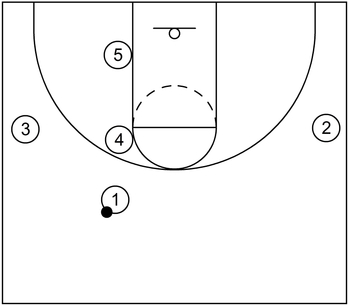
This is an example of the initial formation for the Wheel offense. Also, this example diagram and the ones that follow will utilize the standard basketball positions for demonstration purposes, although the Wheel offense itself could simply feature positionless players.
To start, the point guard, indicated as player 1, begins in the left slot. The shooting guard, indicated as player 2, begins at the right side wing area. The small forward, indicated as player 3, begins at the left side wing area.
The power forward, indicated as player 4 begins at the left side high post elbow area. The center, indicated as player 5, begins near the left side low post area.
It should also be said that each player could actually start at any of the denoted areas as the offense itself is flexible. For example, the point guard could start at the high post or low post and the center could start at the wing or in the slot.
This is valid because each player would inevitably rotate to a new area at some point during offensive execution as mentioned in an earlier section.
What are the general rules for the basic scoring options within the Wheel offense
The general rules that players should follow for the basic scoring options within the Wheel offense are to pass to the wing, screen away from the ball, and cut towards the basket or high post elbow areas.
Pass initially to the weak side wing
When the ball is in the strong side slot during the initial phase of the Wheel offense, the offensive player that is in current possession of the ball should execute a skip pass to the offensive player near the weak side wing.
Also, the weak side wing player could execute a V-cut prior to receiving the ball to get open with more space between themselves and the defender that is currently assigned to guard them.
Cut to the basket and then, the strong side low post block from the weak side wing
Following the strong side slot to weak side wing pass, the ball has changed sides of the floor so the offensive player that is on the new weak side wing should cut to the basket via an angled back screen set by the new weak side low post player.
It should also be noted that the angled back screen should be set about a step or two away from the weak side low post block.
Next, the weak side wing cutter could receive the ball and score at the rim if that is open. On the other hand, if the cutter does not receive the ball, then that same cutter should fill the strong side low post area.
Set a stagger screen away from the ball
After the cut to the strong side low post, the offensive player that executed the skip pass should set a stagger screen away from the ball alongside the offensive player near the weak side high post elbow area.
Cut to the strong side high post elbow from the weak side low post block
Next, the weak side low post player that set the angled back screen should cut to the strong side high post elbow area via the stagger screen action.
Fill the strong side slot and weak side wing
After the stagger screen action completes, the offensive screener that was originally near the weak side slot should fill the weak side wing area.
Additionally, the offensive screener that was originally near the weak side high post should fill the strong side slot.
Initiate the continuity pattern
At this point, it is now possible to initiate the continuity pattern of the Wheel offense with the same passing, screening and cutting actions on the other side of the court.
What are examples of basic scoring options within the Wheel offense
Part 1
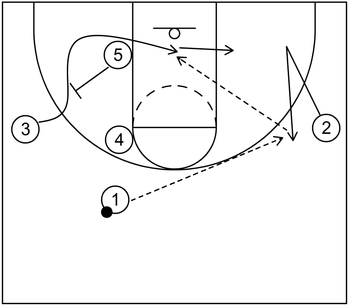
This is the initial phase of the basic scoring options within the Wheel offense. To start, 2 could get open by utilizing a V-cut. Afterwards, 2 could receive the ball from 1.
After that occurs, 3 could cut to the basket via the angled back screen set by 5, receive the ball from 2, and then score at the rim.
If 3 is not open after cutting to the basket, then 3 should cut across the lane to fill the right side low post area.
Part 2
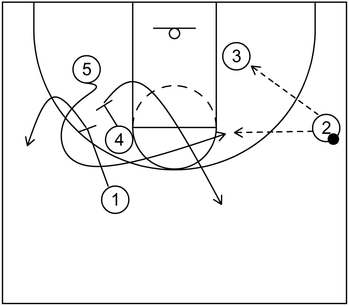
Next, 5 cuts to the right side high post elbow area via the stagger screen set by 1 and 4. This is also screen the screener action because 5 received a screen after setting a screen.
Following that action, 5 could receive the ball from 2 and take the mid-range shot if that is open. Additionally, if 5 does not receive the ball, then 3 could receive it instead and score with a low post move if that is viable.
Furthermore, if 3 or 5 don’t receive the ball, then 1 should fill the left side wing while 4 fills the right slot area.
Part 3
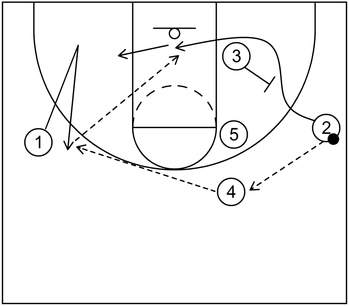
If no players attempted a shot after the initial screening and cutting, then this triggers the continuity phase of the basic scoring options.
Therefore, 4 receives the ball from 2 and then 1 could get open with a V-cut to receive the ball from 4.
Afterwards, 2 cuts to the basket via the angled back screen set by 3. Next, 2 could receive the ball from 1 and score at the rim. However, if 2 does not receive the ball, then 2 would continue through the lane to fill the left side low post area.
Part 4

Next, 3 cuts to the left side high post elbow area via the stagger screen set by 4 and 5. From there, 3 could receive the ball from 1 and take the mid-range jump shot if open.
On the other hand, if 3 is not open, then 2 could receive the ball from 1 and attempt to score with a low post move if it is practical to do so.
If neither 2 or 3 receive the ball, then 4 could fill the right side wing area while 5 fills the left slot area. Afterwards, the continuity could get executed once again.
What is an example of a basic counter variation within the Wheel offense
Part 1

This is an example of a basic counter when X2 implements denial defense in an attempt to prevent the initial slot to wing pass.
When that occurs, 1 dribbles toward the right side wing. This dribble action triggers an automatic backdoor cut by 2.
If 2 is open, then 2 could receive the ball from 1 and then score at the rim. Conversely, if 2 is not open, then 1 could continue the dribble through to the right side wing.
Also, 3 would follow behind 1 to fill the vacated left slot area while 5 follows behind 3 to fill the vacant left side wing area. Additionally, 2 fills the empty left side low post area after the backdoor cut action occurs.
Part 2
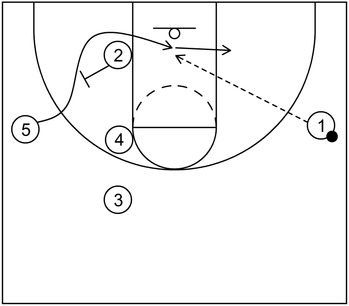
Next, the players would execute the basic scoring options of the Wheel offense as normal. So, 5 would cut to the basket via the angled back screen set by 2, receive the ball from 1, and then score at the basket.
If that is not open, then 5 would cut across the lane to the right side low post block.
Part 3
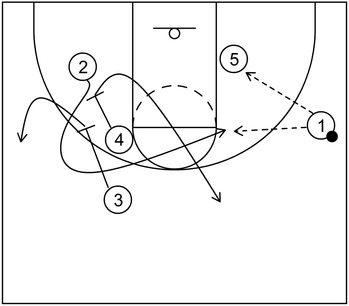
Following that, 2 would cut to the right side high post elbow via the stagger screen set by 3 and 4.
Afterwards, 2 could receive the ball from 1 and take the open mid-range jump shot. Otherwise, 5 could receive the ball from 1 instead and score with a low post move.
If those options are not there, then 3 would fill the left side wing, 4 would fill the right slot, and then the players would execute the continuity pattern of the Wheel offense.
Related: Garland Pinholster Wheel Offense Playbook by Wes Kosel